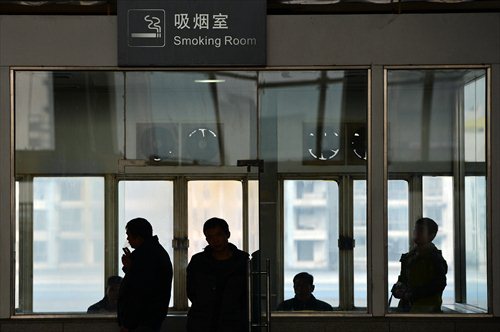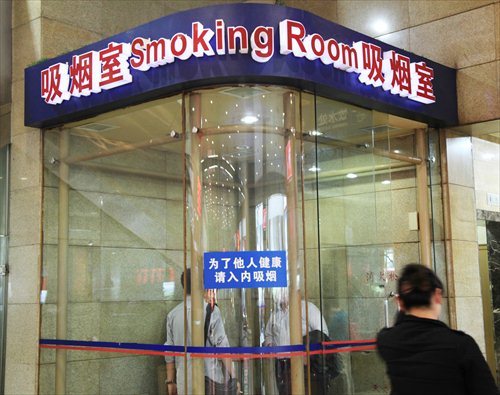Shanghai authorities mull legislation changes for a smoke-free city

Students promote tobacco control on the street. Photo: IC
May 31, 2016 is a special World No Tobacco Day in Shanghai as the authorities are working on amendments to the Regulations of Shanghai Municipality on Smoking Control in Public Places. Introduced in 2010, the regulations banned smoking in 13 types of public areas like schools, hospitals and shopping malls.
However, it allowed some venues, like restaurants and public transportation hubs, to set aside smoking rooms and smoking sections, allowing loopholes in the enforcement of the law.
Recently, a pregnant woman who tried to stop a man from smoking in a restaurant in a shopping mall in Shanghai was abused by the smoker, according to eastday.com. The video of the man shouting at the woman went viral online, igniting heated discussions. Later reports revealed that the smoker was a brand manager for the restaurant. He caused discomfort by smoking in an indoor public area.
Confusion reigns
Zheng Pinpin, the director of the Tobacco Control Research Center from the Health Communication Institute, Fudan University, told the Global Times: "The business area of a shopping mall should be smoke-free. The restaurant was located in a shopping mall. However, if the restaurant has an area larger than 150 square meters or has more than 75 seats, it is allowed to set up smoking sections. People could be confused as to whether they were allowed to smoke here or not."
She believes that the regulations on tobacco control should be simple and clear. "If smoking is banned in all indoor public spaces, there won't be any confusion like this. I think the authorities should simplify the laws and give clear instructions on whether smoking is allowed in these areas or not," Zheng said. Experts pushing for a smoke-free Shanghai where smoking is banned in all indoor public spaces, agree with Zheng.
Yin Xi is the director of the China program for Campaign for Tobacco-Free Kids, an NGO that fights for tobacco control in many countries.
"We are paying very close attention to the amendments of the regulations in Shanghai. The first legislation was made very early, but it did not follow the WHO Framework Convention on Tobacco Control (FCTC) guidelines. Allowing some venues like restaurants to set up smoking sections can't protect people. It also makes law enforcement difficult," Yin told the Global Times.
Bernhard Schwartländer, the World Health Organization's representative in China, believes that making Shanghai smoke-free means making all indoor public places 100 percent smoke-free.
"There must be no exemptions, because there is no safe level of exposure to second-hand smoke. Allowing exemptions or loopholes in any public places - including allowing for designated smoking areas in any public places, for instance in airports, train stations, hotels, offices - will mean Shanghainese are not protected from something that could kill them. And that just is not acceptable," Schwartländer told a press conference on Sunday.
A crucial aspect
According to Sheng Xinchun, director of the Center for Patriotic Campaigns and Health Guidance in the Pudong New Area, a crucial and possibly contentious aspect of the amendments to the regulations in Shanghai would be if the authorities ban smoking rooms and smoking sections in restaurants, airports, train stations and offices in the city.

Smokers keep the door of a smoking room open at a railway station. Photo: CFP
Zheng said China has learned about smoking rooms from other countries. There are smoking rooms in many airports in Europe - smoking rates are still high in Europe. However, 27 of the 35 busiest airports in the US are now smoke-free.
"It has been established that smoking rooms are not feasible. The FCTC states in the Article 8 that authorities should provide protection from exposure to tobacco smoke in indoor workplaces, public transport, indoor public places and, as appropriate, other public places. Scientific evidence has unequivocally established that exposure to tobacco smoke causes death, disease and disability. It cannot be assumed that people inhaling second-hand smoke are safe even if the concentration of the smoke is lower or the exposure time is shorter," Zheng said.
The Tobacco Control Research Center of Fudan University was established on March 25. Tobacco control is a systematic approach that needs the coordination of several public departments. The center has created a platform and is inviting academics, governmental officials and NGOs to promote tobacco control from different aspects.
Knowing Shanghai is amending its smoking control regulations this year, it has researched air quality in smoking rooms and public opinion on smoking.
Over the safe level
The center tested the level of PM2.5 (particles less than 2.5 micrometers in diameter) at two smoking rooms at the Hongqiao Railway Station, one smoking room at the Shanghai Railway Station and one smoking room at the Shanghai Nanzhan Long-distance Passenger Transportation Station. In the smoking room at the Shanghai Railway Station levels of PM2.5 were measured at 2,535 micrograms per cubic meter, 100 times the safe level of PM2.5 (25 micrograms per cubic meter), as recommended by the WHO. The levels of PM2.5 were 592 and 1,221 at the two smoking rooms at Shanghai Hongqiao Railway Station. And the level of PM2.5 at the Shanghai Nanzhan Long-distance Passenger Transportation Station was 804.
"It is a misunderstanding that smoking rooms help people. Smokers do not like staying in smoking rooms. They often leave the doors to smoking rooms open because the air quality inside is too bad. Or, often, smokers smoke at the door of a smoking room instead of smoking inside. Smoking rooms are not protecting smokers at all," Zheng said.
Furthermore, the levels of PM2.5 in the areas around the smoking rooms are high. The level of PM2.5 at the door of the smoking rooms can reach 909 micrograms per cubic meter. Even testing five meters away from the door of smoking rooms saw PM2.5 levels reaching 124.
"Smoking in a smoking room does not protect the non-smokers either. Smoking rooms usually have automatic doors. Every time a door opens, 10 percent of the air circulates. The concentration of second-hand smoke within 5 to 10 meters of the door of a smoking room is still a lot higher than other places," Zheng said.
The public is aware of the problem. The Tobacco Control Research Center surveyed 699 people at these public transportation hubs and more than 80 percent said they could smell cigarette smoke when they walked past smoking rooms, and 70 percent tried to avoid the areas. Some 64 percent of those interviewed supported banning smoking rooms in public transportation hubs.

A woman walks by a smoking room at a railway station. Photo: CFP
The Fudan Media and Public Opinion Research Center (FMORC) surveyed 2,004 Shanghai citizens in May and found 95.8 percent of respondents believed that second-hand smoke was very harmful to health, and 84.8 percent of the smokers questioned also believed so.
A total of 91.3 percent hoped that the amended regulations would be stricter on tobacco control and 85.8 percent supported banning smoking in all public indoor areas. Of the smokers surveyed, 72.1 percent also supported stricter regulations.
Fu Hua, the director of the Health Communication Institute from Fudan University, said although it would seem that banning smoking indoors was infringing on smokers' rights, it was actually protecting smokers. Smokers agreed with this action. "But if there are no compulsory measures, it will be hard to achieve this goal."
Convention signed
China signed the FCTC in 2003 and it came into force in January 2006. This is a multilateral treaty on public health and an international law. The convention provides guidance for signatory countries on tobacco control. Although China is a major tobacco consumer and it was considered by many that it would be impossible to implement the convention in China, in 2015 Beijing banned smoking in all indoor public spaces. Other cities like Qingdao, Shenzhen, Harbin and Yinchuan have followed suit.
"Shanghai as an international metropolitan should not fall behind. Shanghai is among the most advanced cities in economic development and urban governance, so it really should have banned smoking in indoor public space," Zheng Pinpin said.
The FMORC survey showed that 91.7 percent of respondents said they would obey the law if it banned smoking in indoor public spaces and workplaces. And 56.2 percent said they would be more willing to dine out if restaurants and bars are smoke-free.
Talking about non-smoking sections in restaurants, Professor Fu quipped: "The non-smoking section of a restaurant is like a non-peeing section in a swimming pool."
Newspaper headline: All puffed out